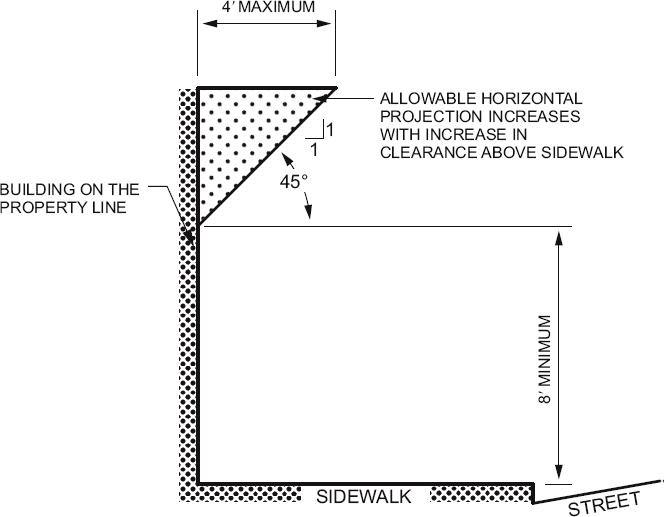Above-Grade Building Encroachments in the Public Right-of-Way
INFORMATION BULLETIN
302
June 2023
This bulletin clarifies allowable above-grade building encroachments into the Public Right-of-Way (ROW). For other encroachments please see Information Bulletin 576.
Permit Process
Allowable above-grade building encroachments may be permitted with an associated Building Permit. A separate Right-of-Way Permit is not required.
- Section 2 of the Project Submittal Manual describes the documents typically required when submitting a building permit.
- Above-grade building encroachments require form DS-3237B - Encroachment Maintenance Agreement to be signed by the owner of the property benefitting from the encroachment. The Encroachment Maintenance Agreement is recorded in the Office of the County Recorder as an encumbrance against the benefitting property.
Encroachment Requirements
- No above-grade building encroachments of any type are allowed to extend into an alley.
- The building must be allowed to be located at the property line by the underlying zone or otherwise allowed to be at the property line by a deviation, incentive or waiver.
- The parkway, measured from the curb to the property line, shall be consistent with the Street Design Manual and any other applicable requirements. This includes but is not limited to the Complete Communities regulations and the Community Plan Implementation Overlay Zone. Please view the Urban Parkway Guidelines Presentation for additional information.
- Above-grade building encroachments over the parkway shall not be above any utility equipment, furniture, street trees or similar items, including driveways.
- Encroachments above an SDGE facility require a letter of approval from SDGE.
- A minimum vertical clearance of eight feet above grade is required for unoccupied or non-habitable space. The vertical clearance shall increase by a ratio of 1:1 based on the length of the horizontal encroachment. For every inch of horizontal encroachment, there shall be an additional one inch of vertical clearance.
- A maximum horizontal encroachment of four feet is allowed regardless of vertical clearance.
- Occupied or habitable encroachments must be at least 15 feet above grade. For purposes of this bulletin occupied or habitable includes any usable space, including balconies.
- Occupied or habitable encroachments may be further limited by the presence of geologic fault hazards, fire access and ladder requirements, existing or planned public utility and transportation facilities, and health/safety concerns specific to the project site and building design.
- The distance of the horizontal encroachment into the ROW must be measured from the property line after any required dedications. Fully constructed public improvements must be provided.
- Horizontal or vertical measurements are taken to the outermost portion of the encroachments, including any decorative elements and trim.
- In the Centre City Planned District Ordinance, located in Downtown San Diego, there is a special allowance for oriel windows, which may contain floor area for certain, but not all uses.
- The Old Town San Diego Planned District prohibits any building encroachments.
- Above-grade building encroachments are not allowed in the Coastal Overlay Zone.
Encroachment Diagram
Encroachments must comply with the minimum and maximum dimensions shown in this diagram.

Relevant and Differing Regulations for Above-Grade Building Encroachments
The San Diego Municipal Code and the California Building Code have different objectives when allowing encroachments into the ROW. These different objectives cause the allowance for encroachments to not be consistent.
SDMC Chapter 12, Article 9, Division 7, Public ROW Permits
SDMC 129.0710(a)(8) allows above-grade structures to encroach up to four feet into the ROW, provided the encroachment is at least eight feet above the finished grade of the curb line. This Section is not applicable in the Coastal Overlay Zone.
SDMC Chapter 14, Article 2, Division 6, Public Facility Regulations
SDMC Section 142.0610 describes public improvements, such as additional ROW dedications and ROW improvement installations. Above-grade building encroachments must be measured from the property line location after any required project dedications. The width of a fully developed ROW, including parkway, is also a determinant for above-grade building encroachments.
SDMC Chapter 15, Article 6, Division 3, Centre City Planned District
This section is specific to sites located in the Centre City Planned District ordinance, located in Downtown San Diego. For these properties, there is a special allowance for oriel windows, which may contain floor area for certain, but not all uses, as described in SDMC Section 156.0311.
SDMC Chapter 15, Article 16, Division 1
This section is specific to sites located in the Old Town San Diego Planned District. For these properties, no building encroachments into the ROW are permitted, as described in SDMC Section 1516.0128(b)(4).
CBC Section 3202, Encroachments into the ROW
The State of California Building Code considers encroachments from a building and structural perspective and provides clearance requirements for different encroachment types. CBC Section 3202.3.2 allows projecting windows, balconies, architectural features, or mechanical equipment to encroach a maximum of four feet, provided the vertical clearance is more than eight feet, with one inch of encroachment permitted for each additional one inch of clearance above eight feet. While this section does not specifically address habitable floor areas, CBC Section 3202.3.3 does not limit encroachments that are 15 feet or more above grade. Therefore, habitable floor area encroachments into the ROW may be allowed by this section provided a 15-foot vertical clearance is provided, and all other requirements are met.
References
- Information Bulletin 576 – How to Obtain a Permit for Encroachments in the Right-of-Way.
- https://www.sandiego.gov/sites/default/files/dsdpsm_sec_02.pdf.
- DS-3237B - Encroachment Maintenance Agreement.
- Urban Parkway Guidelines Presentation.
- SDMC- San Diego Municipal Code.
- CBC – California Building Code.

